Two months after a North Carolina aquarium revealed their round stingray was expecting — despite never interacting with a male stingray — followers of the pregnancy are wondering how, exactly, this could have happened — and when these miraculous babies are going to appear. And the aquarium’s executive director tells TODAY.com that even her understanding of the pregnancy has narrowed since she first announced the news.
For eight years, Charlotte the stingray has resided at the Aquarium & Shark Lab by Team ECCO in Hendersonville, North Carolina. According to the aquarium’s executive director, Brenda Ramer, she was adopted from a private home outside the city of Charlotte, North Carolina and is estimated to be between 12 and 16 years old.

Despite Charlotte never encountering a male round stingray since arriving at the aquarium, a February livestream of an ultrasound at the aquarium showed that Charlotte is pregnant.
"We found out that Charlotte is expecting, and it's a really strange and unique phenomenon," Ramer explained during the livestream ultrasound. "She's carrying somewhere between three and four pups."
Users were quick to express their fascination about how exactly the stingray became pregnant. One theory Ramer presented is that she was impregnated by sharks who shared her tank at one point.
"I’m sorry, she may have mated with a shark?" one viewer commented on the livestream.
“I had no idea it was possible for a shark to impregnate a stingray,” another wrote.
Now, months after her pregnancy announcement, some users have grown wary of the likelihood of her pregnancy.
"I thought they (were) only pregnant for a couple of months," one user commented in a recent update about Charlotte from the aquarium. "It’s been way over that. Are you sure she’s pregnant or is this just for views?"
To learn more about the possibility and circumstances of Charlotte's pregnancy, TODAY.com spoke to Ramer and a stingray expert for answers. Here's what we learned.
How did Charlotte the stingray get pregnant?
In the aquarium's February announcement of Charlotte's pregnancy, Ramer offered two possibilities for her status — the first one being the shark theory.
Benjamin M. Perlman, who has a doctorate in biology and is a lecturer at California State University — Long Beach’s Department of Biological Sciences, researches and studies stingrays. Speaking to TODAY.com, he says that cross-species mating and reproduction aren't possible in this case.
He explains that “the morphology of the male shark won’t necessarily fit with the morphology of the female round stingray.”
In the months since her livestream announcement, Ramer tells TODAY.com she now believes Charlotte became pregnant through parthenogenesis.
Britannica defines parthenogenesis as a "reproductive strategy" in which a female can develop and produce offspring without fertilization.
In a typical pregnancy, a female's eggs are fertilized by a male's sperm. According to Perlman, in parthenogenesis, instead of male sperm, another cell from the female combines with the egg. This cell carries the additional DNA needed, and it's from the female herself.
“So you have a complete set of DNA, but not from the female and the male. It’s from the female and that same female,” he explains, adding that the result is an offspring that essentially becomes a mild clone version of its parent.
Perlman says that in order to know for sure if Charlotte's pregnancy is a case of parthenogenesis, we have to wait for her to give birth in order for DNA samples to confirm anything.
“You’ll be able to see if there was any presence of sperm, you know, from some male counterpart or if it was just from the female,” he explains. “So that’s why everybody has been anxiously waiting for Charlotte to hurry up and give birth.”
When did Charlotte the stingray get pregnant?
Kinsley Boyette, an assistant director of the Aquarium and Shark Lab by Team ECCO, tells TODAY.com that staff learned Charlotte developed eggs in December after they began to notice changes in her body and behavior.
“She definitely got much rounder,” Boyette explains, adding that while humans carry their progeny in their stomachs, stingrays carry theirs in their backs. “We noticed that she couldn’t completely bury herself underneath the sand, and that is what moved us to perform the ultrasound.”
Boyette says that it was during the ultrasound they discovered she was pregnant.
“We sent the data to our colleagues, and they are the ones that helped us confirm her (pregnancy results),” she explains.
Ramer notes that because she and her staff are unaware of how long Charlotte’s eggs had been inside of her prior to the ultrasound, they’re not sure when the suspected parthenogenetic process could have started.
When is Charlotte expected to give birth?
According to Perlman, in a typical stingray pregnancy — wherein a female has been impregnated by a male —the expected period of gestation is three to four months.
"But it could be a little bit longer (for Charlotte), or could be a little bit shorter, especially in captivity, with the conditions being a little bit different than the wild," he explains, adding that experts don't have a precedent for gestation periods when it comes to parthenogenesis in round stingrays.
“If (Charlotte) is capable of having undergone parthenogenesis, it would be the first documented case in this species of the round stingray, which is pretty neat,” he notes.
What does the aquarium have to say about the skepticism around Charlotte's pregnancy?
“We look at it as a once-in-a-lifetime gift,” Ramer says. “And I think that’s how people should look at it. It’s a gift and we’re trying to share the experience in the wonder of the oceanic world.”
